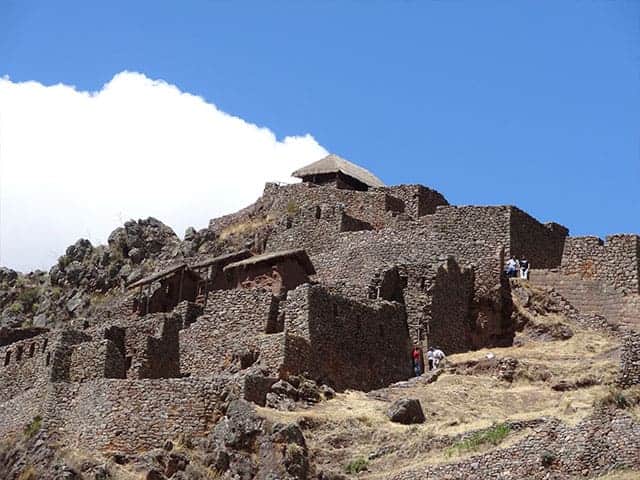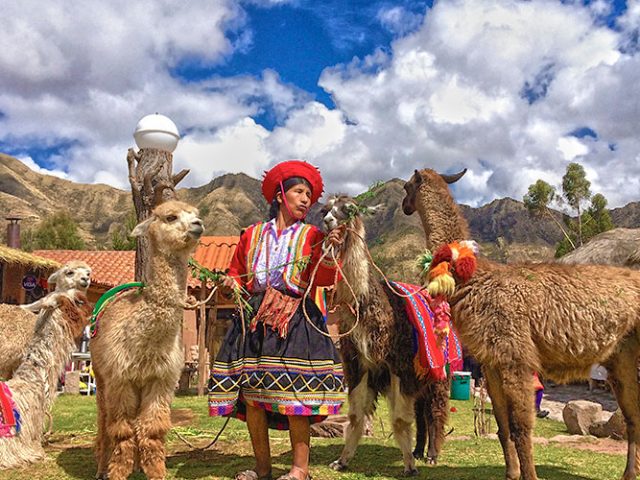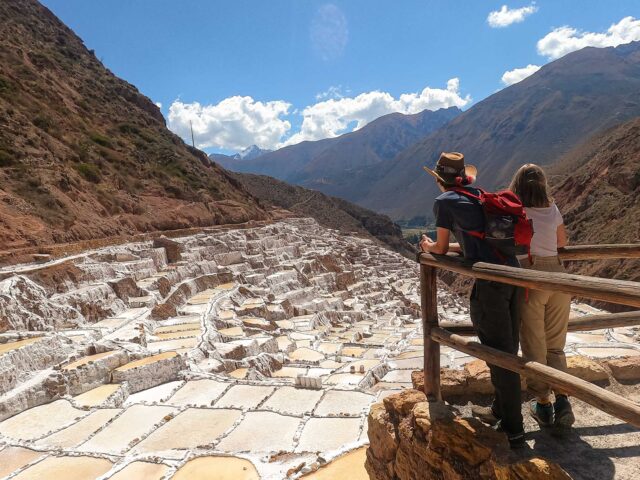Pisac Ruins
Discover the enchanting town of Pisac, Peru with this comprehensive travel guide. From ancient ruins to vibrant markets, this destination has it all!
Nestled in the heart of the Sacred Valley of the Incas, Pisac, Peru is a charming town that offers visitors a glimpse into the rich history and culture of the Andean region. From exploring ancient ruins to shopping at vibrant markets, there’s something for everyone in this enchanting destination. Read on for a comprehensive travel guide to Pisac, Peru.
The Pisac ruins are located 33 km east of the city of Cusco. You can get there through some of our tours that include this archeological site to the Sacred Valley. Although you can also use the public transport that goes to Urubamba that leaves every 15 minutes, you must get off at the bridge and from there you must go to the back of the temple of Pisac in a walk of about an hour.
Pisac Inca site is made up of groups of archaeological remains among which we can find platforms, aqueducts, paths associated with walls and gates, canalized watercourses, cemeteries, bridges, and so on. The total size that occupies the arequeologico site of Pisac has an area of 4 square km of surface.

What to See at Pisac Ruins
The beauty of its walls, built with large blocks of polished stone with extraordinary symmetry and unparalleled handling of the stone leave all visitors impressed.
At first astonishment is inevitable, then a feeling of deep respect for the creators of those buildings that are hundreds of years old.
The archaeological complex of Pisaq is made up of a group of enclosures that are possibly dwellings, aqueducts, paths, bridges, a cemetery, walls and large areas of enormous platforms.
This population has an Inca part and a colonial part. Písac and its main square, is an entertaining place full of color and with diverse handcrafted articles for sale. This town is known for its astronomical observatory. The architecture of Pisac is also mestizo built on indigenous remains by Viceroy Francisco de Toledo.

Useful information
- Location: 33 km from the city of Cusco (1 hour approximately).
- Average temperature: between November and March, with average temperatures of 12 °C (54 °F), between April and October, with cold nights, sunny days and average temperatures of 9 °C (48 °F).
- Season: Cusco has two well-defined seasons: a rainy season, between November and March, and a dry season (the best time to visit) between April and Octobe

Pisac Tourist Attractions
Acchapata Platform Group
At a distance of only 200 meters up from the village square of Pisac we can find a beautiful group of platforms. This group consists of 40 platforms forming a kind of triangle with vertex down, which means that the smaller platforms we see below and as we go up the size increases.
Towers or Pucaras in Pisac
In de Pisac we will find more than 20 towers and they are of two types: The habitat towers and the watchtowers; the first ones are conical enclosures used for the canalization of construction
water with perfectly carved and assembled pieces, these seem pulpits attached to the mountain. The watchtowers are beautiful elevations, with conical tendency, they are not enclosures, its texture is solid and its interior compact mass plus its portion is flat surface. The most important at your location is Qoriwayrachina.
Intiwatana neighbourhood in Pisac
In the central zone we will be able to find a series of temples and palaces, with a greater architectural quality of construction, greater beauty in its walls, the enclosures are bigger in relation to those of other districts. This area has 3 levels to gain aesthetics and comfort, modular buildings directed towards the main valley. In this place we can find: The central enclosure, the Intiwatana, the altar carved in volcanic breccia, groupings of liturgical fountains, alleys and courtyards.
Tianayuc Neighborhood
It is known as Tianayuc, which translates from the Quechua language to “which has a seat” since in the inner courtyard there is a kind of sofa for two people, with a back and elbow pads made of stone. This area is small, with rooms whose doors overlook a central courtyard, plus an almost destroyed tower that dominates much of the K’itamayu ravine.
K‘allaQ‘asa Neighbourhood
This area is the largest of the other neighborhoods of the archaeological complex of Pisac. It was built on top of the mountain the highest altitude of all enclosures, its enclosures move on a plane inclined downward towards the North. It has many rooms, steep slopes, towers, a short tunnel 3 meters long, this neighborhood has on its sides impressive ravines.
Pisaq’a Neighbourhood
It is located two hundred meters away from the neighborhood of Intiwatana and at a lower altitude. This neighborhood was built until the ground is completely flat. The form of this district is semicircular obeying the form of the mountain, this set consists of 23 enclosures built with astonishing order.
Neighbourhood of QanchisRaqay
In this zone we will be able to find many constructions, the houses are constructed of medium and small stones, the plane of the set is inclined that arrives at the slope where it is the brook Chongo. This neighborhood was built with a strategic location from where you can control the entire city of Pisac.
Altitude of Pisac
The ruins of Pisac are located at 3,300 meters above sea level (m.a.s.l.). The town is located at
2,974 meters above sea level.
Weather in Pisac
The climate in Pisac is temperate most of the year. In the village, the climate varies from 2ºC. to 21ºC. There are two seasons: the dry season (April to October) and the rainy season (November to March). In the latter the rains occur more frequently. The days are mostly sunny and the nights are cold.

Entrance tickets to Pisac
The Cusco Tourist Ticket is the cheapest way to visit Pisac because it also includes many other archaeological sites:
- General tourist ticket: S/. 130.
- Partial tourist ticket: S/. 70.
Best time of year to visit Pisac
The low rainy season (April to October) is the best time to visit Pisac. During those months there is less chance of rain so the excursion is easier. It is recommended to make the visit in the early hours of the morning.
Pisac Market
In its main square of Pisac under the beautiful trees on Tuesdays, Thursdays and Sundays are organized craft fairs that are very popular for the diverse and colorful textiles and decorative ceramics that is offered there, it is interesting to visit these markets as others such as Chinchero, as we can buy some souvenirs that are unique for their handmade, there are no two different.
Sunday Masses
The inhabitants of this village and the nearby peasant communities are of Catholic traditions, so they are no strangers to the celebrations of the Eucharist. In the temple of Pisac, a Sunday mass is celebrated in Quechua (the language of the Incas) with the assistance of the mayors or varayoc wearing native costumes and accompanied by the sound of pututos.
Some recommendations to visit Pisac
- Bring a bottle of water before and during the walk.
- Hiking shoes are recommended. That way you’ll avoid sprains and accidents.
- Bring rain poncho with you. It is not known when river rainfall will occur.
- The day is hot so it is advisable to wear a hat, sunscreen and sunglasses.
- The best way to understand Pisac is with the company of a tour guide. The tours include this service. Another option is to hire one at the entrance door.
How to get to Pisac
To get to Pisaq you can take a Sacred Valley Tour on Tuesdays, Thursdays and Sundays arriving at the Pisaq handicraft market which is open on the days mentioned but not going to the ruins of Pisaq; you can also do so on any of our private tours on the day you want, it will take about half an hour to get to the archaeological site of Pisaq from the town of Pisaq.

Preparing for your trip to Pisac
There are several things people can do to prepare for this type of walk. However, it is necessary that people who are preparing to make all kinds of walks in Cusco should take into account the altitude sickness. This is a very common but underestimated disease. Many travelers are greatly affected by altitude sickness, which can manifest itself in a variety of ways: from shortness of breath and mild headaches to being completely bedridden for several days. Although it only slightly affects some people, it can be very serious, can even endanger the lives of others and should not be ignored by anyone.
There are several different ways to treat altitude sickness, however, it is much more advisable to prepare in advance. The best way to do this is to ascend gradually to the city of Cusco and spend 24 hours on each 2000 foot increase is what is recommended to properly adjust to the altitude. The optimal way to do this in Peru is to take a bus from Lima to Cusco instead of flying directly. The slow and progressive ascent of this route allows the human body to adapt to the conditions of altitude, these tips will serve you to visit Pisac, in addition to other tourist destinations in Cusco, such as Machu Picchu.












